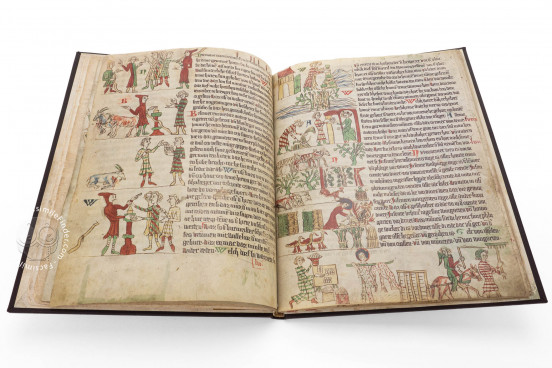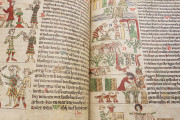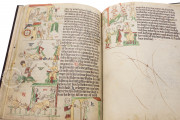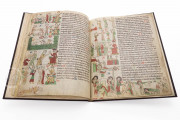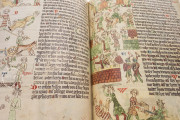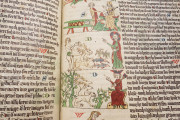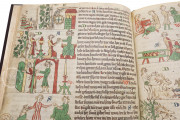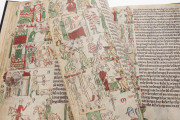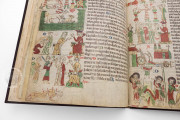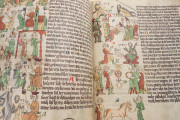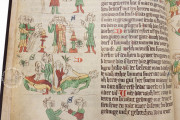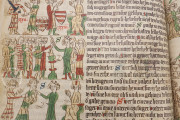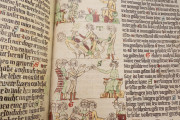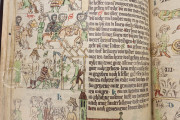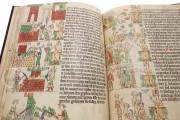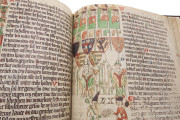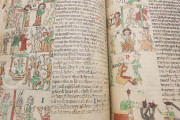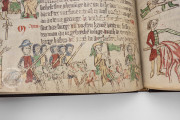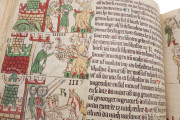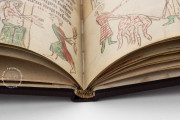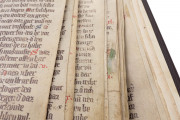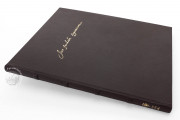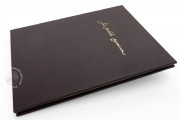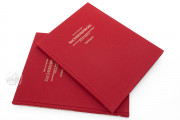The Heidelberg Mirror of Saxony echoes the original text of the Mirror of Saxony which has played a great part in the creation of German law, representing – after centuries of verbal legal tradition – the first attempt at recording everyday life and reporting the legal laws carried out in the geographical region of Saxony, southern Germany. The Heidelberg manuscript is based on the work of Eike Von Repgow, who wrote it between 1220 and 1235 in his native language i.e. German, and constitutes a superb example of Gothic illumination.
Speculum Literature of the Heidelberg Mirror of Saxony
The title takes after the speculum literature typical of the Middle Ages. The work, like a mirror, would reflect the world of Christianity, additionally providing legal aid. The text, starting with the author's exhortation to follow the law, first provides a common law regarding constitutional and procedural law, and then enlists the laws of feudal rights.
An Everyday Tool
The date of the Heidelberg Mirror of Saxony remains uncertain, but a few elements, such as script and the coat of arms from the Harz region, lead us to place the date of creation between 1295 and 1304. Unfortunately, only part of the manuscript has survived time, with the entire first parts, and portions of the second and third book gone missing.
The codex would have contained about ninety-two pages, which, due to heavy and frequent use indicated by the presence of finger-marks and abrasions, were worn out and ultimately not preserved up until modern days.
Derived from the Original Text by Eike von Repow
The significance of the Heidelberg Mirror of Saxony stands in the similarity of the text to the original by Eike von Repow and in the time frame in which both works were produced, for it is believed that the original text, now lost, emerged only a few decades earlier than the one made in Heidelberg, so much so that also the illustrations were probably derived from the original.
The consistency and harmony between image and text is one of the most striking elements of the Heidelberg manuscript and a great credit to the ability of the illustrator, who managed to translate the written law into a sequence of images. The author conveys the legal aspects of the text through the human figures, the way they dress, hand gestures, and body posture.
In addition to the traditional symbols, the illustrator also creates new forms such as the enlarged representation of hands, which does not appear in later manuscripts. Another medium on which the author often relies on is the use of figures with many arms, as to express the complexity of feudal law.
The Obscure Life of the Manuscript
The life of the Heidelberg manuscript is obscure since its origin up to the late sixteenth century, when it appeared in the accounts from Heidelberg as a result of the creation of a book collection, generally known as Bibliotheca Palatina, which came about after the creation of a university in 1386.
The Heidelberg codex was brought there by one Ulrich Fugger, book amateur and collector who, deep in debt, found refuge in Heidelberg with Prince Friederich III from Pfalz. Fugger's collection was moved to Heidelberg and, upon his death in 1564, he bequeathed it all to the Bibliotheca Palatina.
During the Thirty Years' War, the Roman emissary Leo Alacci brought the manuscript in Rome, where it was safely kept in the collection of the Vatican library until 1816, when Pope Gregor XV returned it to the Bibliotheca Palatina.
We have 1 facsimile edition of the manuscript "Heidelberg Mirror of Saxony": Der Heidelberger Sachsenspiegel facsimile edition, published by Akademische Druck- u. Verlagsanstalt (ADEVA), 2010
Request Info / Price
